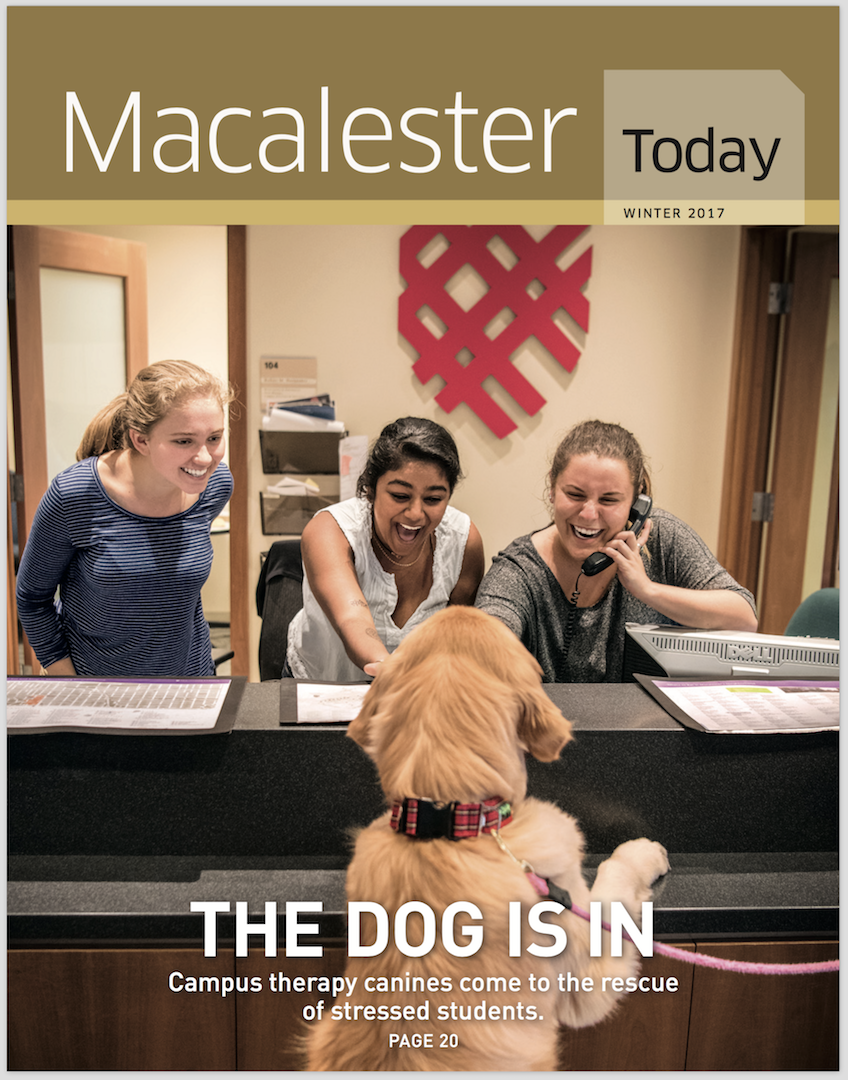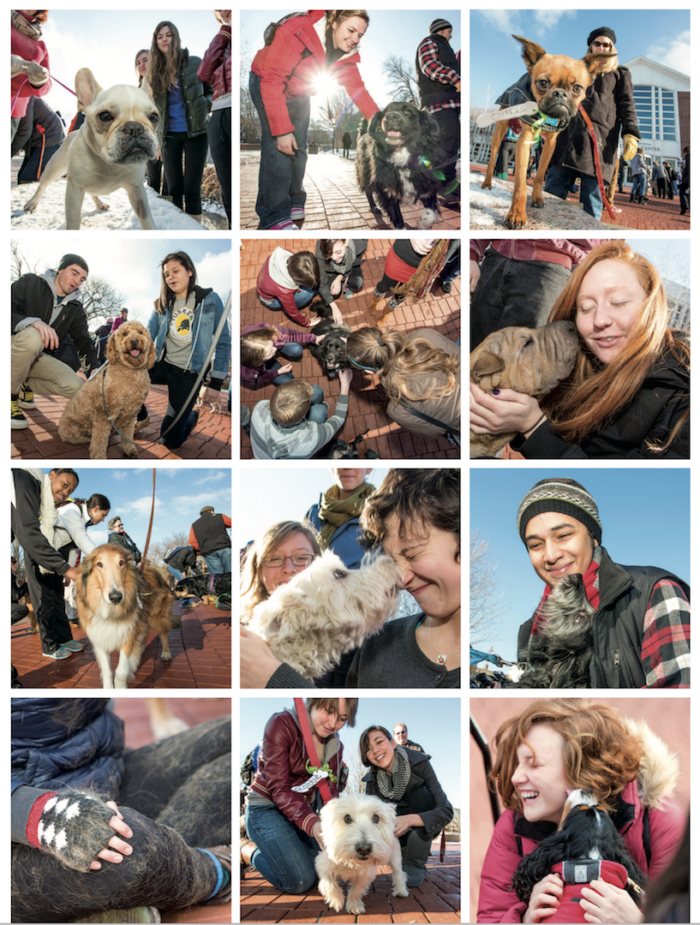The Dog Will See You Now

Campus therapy canines come to the rescue of homesick, heartsick, and homework-stressed Mac students.
On the morning after a stunning presidential election night, when searches for “the five stages of grief” started trending on Google, the student team behind Macalester’s therapy dog program knew just how to start the healing process.
“We posted an old puppy picture of Kevin on his Instagram account, just to let people know he’d be on campus if they needed to see him,” says Emma Burt ’17 (Shoreline, Wash.), who regularly attends to Kevin, the flaxen-bellied therapy dog who has become a celebrity on Mac Social since the Petting Away Worry and Stress program (PAWS) started on campus last fall. The family dog of medical director Dr. Steph Walters, and the self-confident alpha in a growing pack of comforting campus canines, “Kevin’s got a way of making people feel better just by being here,” says Emily Johnson ’17 (Waimea, Hawaii), another of Kevin’s four trained student handlers. “And we figured it could be a busy day for him.”
When the 80-pound pedigreed golden retriever clocked in for his usual Thursday morning session at the library—the same day President-elect Donald Trump and his transition team were making their first visit to the White House—more than 50 Mac students stopped by in almost as many minutes to bask in his golden glow. Some smiled from afar and called out his name (inspired by the rainbow bird in the movie Up). Others scratched his ears, or invited him to lean his large head against their legs. Still others, like Ellie Hohulin ’19 (Glen Ellyn, Ill.), dropped down on all fours to bury her hands in Kevin’s well-groomed fur.
“She’s like Kevin’s number one Instagram fan,” her friend Eleanor Beaird ’19 (Scottsdale, Ariz.) explains as she watches Hohulin and four other female students huddle over Kevin, as he lay prone on the library carpet. “I have allergies so I don’t pet him myself, but I think I get a little something out of seeing him around anyway.”
In fact, simply making eye contact with an engaged dog can prompt an increase in oxytocin, the bonding hormone that reassures humans that everything might turn out okay after all. “Dogs really do pay attention to the human face, and they can respond to emotional cues in a way that can give relief when you’re feeling a quart low,” says psychology professor Jaine Strauss. Petting nearly any animal can lower your heart rate and cortisol level, but the science also suggests that the finely tuned social antennae dogs have adapted over time can make them more beneficial companions than many you’ll find on two legs.
“Studies have actually found that if you bring a close friend into the kind of acutely stressful situation that college students experience all the time, like an exam or an interview, signs of stress reactivity increase in the presence of friend, but are dampened with a dog,” Strauss says. “The presence of a dog seems to offer a very nonjudgmental attention that provides all the benefits of social support, and nothing that hints at your deficiencies or makes you feel bad.”
As colleges cope with a well-documented rise in student anxiety and depression, research like this explains why campuses from Harvard to Berkeley are easing up restrictions on campus pets, and unleashing therapy animals as a low-cost wellness strategy. At Yale University, for instance, law school students can check out a border terrier mix named Monty for 30-minute sessions. This fall, the University of Minnesota campus mourned the death of a 10-year-old therapy chicken named Woodstock, who had more than 1,000 Twitter followers.
At Macalester, “Dog Days” has been a campus tradition since 2006, typically attracting more than 200 exam-stressed students to spend quality time with a dozen or so campus-affiliated canines on the Saturday before each finals week. Service animals are always welcome on campus, while well-tended iguanas, hedgehogs, and other small pets are allowed to cohabitate in residence halls thanks to a fairly liberal policy on low-risk pets weighing under two pounds. (No ferrets or snakes need apply, however.) Though accommodations requests for emotional support animals have gone down slightly at Macalester in recent years, the campus pet trend is so prevalent there are even signs of a “backleash”: Former New York City mayor Rudy Guiliani complained that college students who required such creature comforts after the presidential election were a bunch of “spoiled crybabies.”
 In fact, proponents of the PAWS@Mac program believe the initiative is actually teaching students to be more resilient, as it demonstrates how reaching out to others, refocusing on the present, and taking time to recharge can reduce stress and provide some fresh perspective. “Before Kevin started coming to campus, I used to see students behind closed doors who were really homesick or sad, and I would think, ‘I know a therapy dog who could really help right about now,’” says Dr. Walters. Seeing how positively her college-age patients responded to Kevin during his pilot year (2015-16) inspired her to seek out three additional certified therapy dogs to help fill the need—Murray and Finnegan, golden retrievers owned by communications department staffer Cheryl Doucette, and Leo, a rescued collie owned by special events manager Andi Wulff.
In fact, proponents of the PAWS@Mac program believe the initiative is actually teaching students to be more resilient, as it demonstrates how reaching out to others, refocusing on the present, and taking time to recharge can reduce stress and provide some fresh perspective. “Before Kevin started coming to campus, I used to see students behind closed doors who were really homesick or sad, and I would think, ‘I know a therapy dog who could really help right about now,’” says Dr. Walters. Seeing how positively her college-age patients responded to Kevin during his pilot year (2015-16) inspired her to seek out three additional certified therapy dogs to help fill the need—Murray and Finnegan, golden retrievers owned by communications department staffer Cheryl Doucette, and Leo, a rescued collie owned by special events manager Andi Wulff.
Last year, Kevin had an estimated 2,200 student interactions—effectively sniffing and circling nearly every student on campus. While he and his pack can’t take the place of counselors when it comes to supporting students with real mental health concerns—a presenting problem in a quarter of all student visits to the Laurie Hamre Health and Wellness Center—they may provide some nonverbal encouragement for students to find the help they need. “I remember a student who stopped by right around mid-terms, gave Leo a hug, and suddenly found himself in tears,” says Wulff. “He was surprised by his own reaction. But I think dogs help us connect in that way, and for that student, I think it was just such a relief to have an outlet for those feelings.”
Julia Manor, a visiting assistant professor in the psychology department, says the evidence showing the stress-reducing connections between dogs and humans is strong—but humans could also return the favor by observing some simple rules of canine decorum. “No patting them on the top of the head—dogs really hate that,” says Manor, an animal learning and cognition expert who has also worked as a professional dog trainer. “It’s much better to scratch them under the neck or chest.”
As primates, humans are hard-wired to hug, but for canines, “the basic message of a hug is ‘I’m going to squeeze your neck now. Death is imminent,’” Manor says. “They do learn to tolerate it, but generally it’s very rude.” If a dog turns its back to you, goes stiff, disengages after a round of petting, or flashes the “whale eye” (opening the eyes wide enough to reveal the whites), you may be invading his space. “If you stop petting, and the dog approaches again, that’s an indication that they’re enjoying it and they want more,” Manor explains. “A loose body, a loose wagging tail, and relaxed ears are all signs that a dog is having a good time.”
Manor says there’s even evidence to suggest that @PawsatMac’s Instagram feed is helping to spread a healthy dose of Vitamin Dog to students who don’t have face to fur encounters with Kevin, Murray, Finnegan, or Leo. “When you show people pictures of cute animals, they tend to report lower anxiety and less depression,” Manor says. “It’s a short-term effect, but there’s some evidence that it works. So post more puppy pictures on Facebook and everyone will thank you.”
